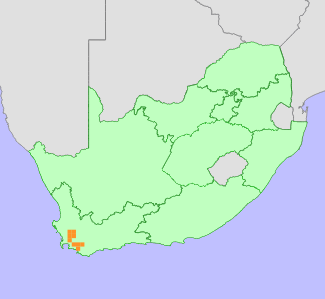|
Scientific Name | Tritoniopsis elongata (L.Bolus) G.J.Lewis |
Higher Classification | Monocotyledons |
Family | IRIDACEAE |
Synonyms | Exohebea elongata (L.Bolus) R.C.Foster, Hebea elongata L.Bolus |
National Status |
Status and Criteria | Endangered B1ab(ii,iii,iv,v)+2ab(ii,iii,iv,v); C2a(i) |
Assessment Date | 2022/07/18 |
Assessor(s) | D. Raimondo, P. Goldblatt & J.C. Manning |
Justification | This Western Cape endemic has a restricted range, with an extent of occurrence (EOO) of 4450 km² and an area of occupancy (AOO) of 124 km², and it is known from 10 severely fragmented subpopulations. All subpopulations are small, and the majority occur on tiny, isolated fragments. No subpopulation has more than 250 plants. The population is declining as a result of crop cultivation and urban expansion around Paarl and Wellington. This species therefore qualifies as Endangered under criteria B and C. |
Distribution |
Endemism | South African endemic |
Provincial distribution | Western Cape |
Range | This species has a restricted distribution range in the Western Cape Province, South Africa, where it occurs from Elandsberg Mountains to Caledon. |
Habitat and Ecology |
Major system | Terrestrial |
Major habitats | Swartland Shale Renosterveld, Western Ruens Shale Renosterveld, Greyton Shale Fynbos, Elgin Shale Fynbos, Boland Granite Fynbos, Elim Ferricrete Fynbos, Swartland Alluvium Fynbos, Breede Alluvium Fynbos |
Description | It grows on hard gravelly or stony slopes. |
Threats |
| This species has already lost most of its habitat to crop cultivation and urban expansion around Gouda, Paarl and Greyton, and only small, isolated remnants remain. These fragments continue to be lost to ongoing agriculture and development, and are otherwise often poorly managed, with mowing, uncontrolled spread of alien invasive plants and inappropriate fire regimes causing ongoing degradation. |
Population |
This narrow endemic is known from seven subpopulation that are severely fragment found between Gouda and Paarl, with an outlier subpopulation near Greyton. The largest subpopulation has no more than 250 plants. Only the Elandsberg and Bontebok Ridge subpopulations are well conserved. The population continues to decline to continuous urban and agricultural expansion and degradation of habitat by alien invasive species.
|
Population trend | Decreasing |
Conservation |
| It is conserved in Elandsberg Private Nature Reserve. |
Assessment History |
Taxon assessed |
Status and Criteria |
Citation/Red List version | | Tritoniopsis elongata (L.Bolus) G.J.Lewis | EN B1ab(ii,iii,iv,v); C2a(i) | Raimondo et al. (2009) | | Tritoniopsis elongata (L.Bolus) G.J.Lewis | Vulnerable | Hilton-Taylor (1996) | | Tritoniopsis elongata (L.Bolus) G.J.Lewis | Indeterminate | Hall et al. (1980) | |
Bibliography |
Goldblatt, P. and Manning, J.C. 2000. Cape Plants: A conspectus of the Cape Flora of South Africa. Strelitzia 9. National Botanical Institute, Cape Town.
Hall, A.V., De Winter, M., De Winter, B. and Van Oosterhout, S.A.M. 1980. Threatened plants of southern Africa. South African National Scienctific Programmes Report 45. CSIR, Pretoria.
Hilton-Taylor, C. 1996. Red data list of southern African plants. Strelitzia 4. South African National Botanical Institute, Pretoria.
Manning, J., Goldblatt, P. and Snijman, D. 2002. The color encyclopedia of Cape bulbs. Timber Press, Portland/Cambridge.
Raimondo, D., von Staden, L., Foden, W., Victor, J.E., Helme, N.A., Turner, R.C., Kamundi, D.A. and Manyama, P.A. 2009. Red List of South African Plants. Strelitzia 25. South African National Biodiversity Institute, Pretoria.
|
Citation |
| Raimondo, D., Goldblatt, P. & Manning, J.C. 2022. Tritoniopsis elongata (L.Bolus) G.J.Lewis. National Assessment: Red List of South African Plants version 2024.1. Accessed on 2025/12/12 |
 Comment on this assessment
Comment on this assessment


